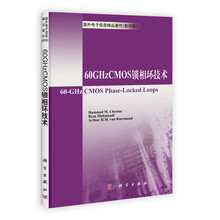1 Introduction
2 Synthesizer System Architecture
2.1 IEEE 802.15.3c Channelization
2.2 60 GHz Frequency Conversion Techniques
2.3 Proposed PLL Architecture: Flexible, Reusable, Multi-frequency
2.3.1 Utilization in WiComm Project
2.4 System Analysis and Design
2.4.1 Phase-Lock Loop Basics
2.4.2 Frequency Planning
2.4.3 Synthesizer Parameters
2.5 System Simulations
2.6 Target Specifications
2.7 Summary
3 Layout and Measurements at mm-Wave Frequencies
3.1 Layout Problems and Solutions
3.1.1 Impact ofParasitics
3.1.2 Mismatch Due to Layout Asymmetry and Device Orientation
3.1.3 Substrate Losses.
3.1.4 Cross Talk Shielding and Grounding
3.2 Measurement Setups
3.2.1 Dedicated Instrumentation
3.2.2 Calibration and De-embedding
3.2.3 Stability and Repeatability
3.3 Conclusions
4 Design ofHigh Frequency Components
4.1 Prescaler
4.1.1 Overview and Comparison of Prescaler Architectures
4.1.2 35 GHz Static Frequency Divider
4.1.3 40 GHz Divide-by-2 ILFD
4.1.4 60 GHz Divide-by-3 ILFD
4.1.5 Monolithic Transformer Design and Measurement
4.1.6 Dual-Mode (Divide-by-2 and Divide-by-3)ILFD
4.1.7 ILFD figure-of-Merit (FOM)
4.1.8 Summary
4.2 Voltage Controlled Oscillator
4.2.1 Overview of VCO Architectures
4.2.2 Theoretical Analysis ofLC-VCOs
4.2.3 40 GHz LC VCO
4.2.4 60 GHz Actively Coupled I-Q VCO
4.2.5 60 GHz Transformer Coupled I-Q VCO
4.2.6 Dual-Band VCO for 40 and 60 GHz
4.3 Synthesizer Front-Ends.
4.3.1 40 GHz VCO and Divide-by-2 ILFD
4.3.2 60 GHz VCO and Divide-by-3 ILFD
4.4 Conclusions
5 Design ofLow Frequency Components
5.1 Feedback Division
5.1.1 CML Based Divider Chain
5.1.2 MixerBasedDivision
5.2 Phase-Frequency Detector, Charge-Pump and Loop Filter
5.3 Conclusions
6 Synthesizer Integration
6.1 Synthesizer for 60 GHz Sliding-IF Frequency Conversion
6.1.1 Comparison to Target Specifications
6.2 Synthesizer with Down-Conversion Mixer in Feedback Loop
6.3 Dual-Mode Synthesizer
6.4 Conclusions
7 Conclusions
Appendix
Appendix A
A Travelling Wave Divider Simulation Results
Appendix B
B LC-VCOs Theory
References

 缺书网
缺书网 扫码进群
扫码进群





